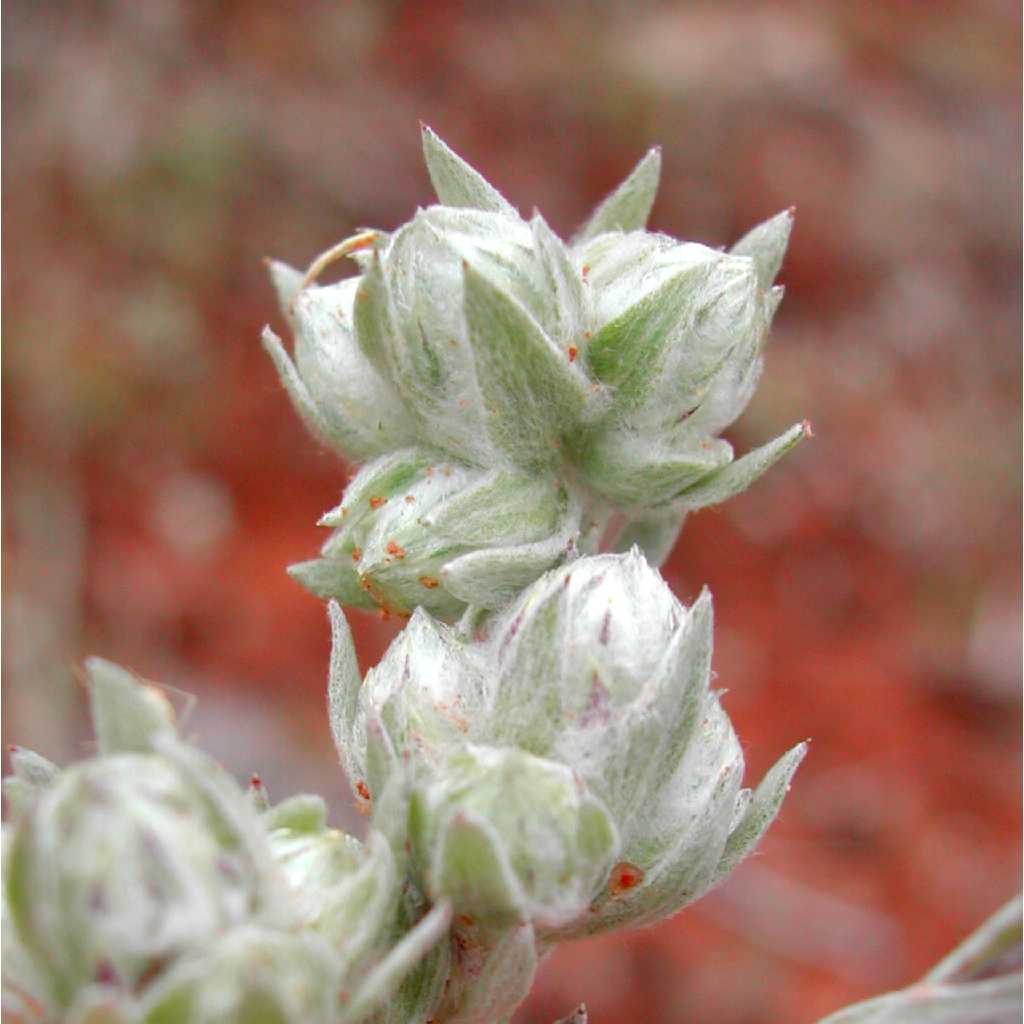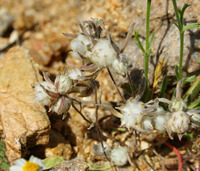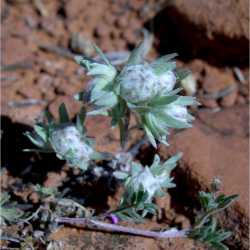|
|
|
|
Family: Asteraceae
woollyhead neststraw
|
Plants 2-14(-20) cm. Leaves acute, mucronate, longest 8-20 mm; largest capitular leaves (some or all) subulate to lanceolate (widest in proximal 1/3), (7-)11-17 × 1.5-2.5 mm (distalmost mainly 1.5-2 times head heights). Heads in ± paniculiform to cymiform, rarely dichasiform arrays, ± spheric, largest 5-9 mm, thickly lanuginose. Phyllaries 0, vestigial, or falling, ± subulate, mostly 0.1-0.5 mm, unequal. Receptacles narrowly cylindric, 2-3 mm, heights 5-8 times diams.; scars ± evenly distributed, ± flat. Pistillate paleae: longest 3.4-4.5 mm, winged distally; wings elliptic to ovate, widest in distal 1/3 of palea lengths; bodies (except midnerves) chartaceous; outermost paleae ± saccate. Functionally staminate florets 3-6; ovaries vestigial, 0-0.3 mm; corollas 1.2-1.9 mm. Cypselae 1-1.4 mm, compressed; pappi: staminate of 2-5(-10) smooth to barbellulate bristles 1.1-2 mm. 2n = 28. Flowering and fruiting Feb-May(-Aug). Relatively stable sandy or gravelly desert soils, often under shrubs, at rock bases; 70-1600 m; Ariz., Calif., Nev., N.Mex., Tex., Utah; Mexico (Baja California, Chihuahua, Sonora). Stylocline micropoides occurs throughout warm deserts of the flora area, through the Grand Canyon to southern Utah and up Owens Valley to the White Mountains of California. Sterile and malformed natural hybrids between S. micropoides and Logfia arizonica have been seen. The description of S. micropoides by D. S. Correll and M. C. Johnston (1970) was clearly based on specimens of L. filaginoides; both species occur near El Paso, Texas.
FNA 2006, Wiggins 1964, Kearney and Peebles 1969 Duration: Annual Nativity: Native Lifeform: Forb/Herb General: Annual branched at or near base with ascending or diffuse stems 2-14 cm tall. Leaves: Acute, mucronate, cauline leaves linear, longest 8-20 mm long by 1.5-2.5 mm wide. Flowers: Heads in a panicle or cyme, rarely dichasiform array, more or less spheric, with the largest 5-9 mm and thickly woolly; no phyllaries, receptacles narrowly cylindric, 2-3 mm, the height 5-8 times the diameter, more or less flat; pistillate flowers numerous, enclosed in the woolly bracts, without laterial wings but the apical half forms an oblong-ovate, hyaline, glabrous tip, with 3-6 staminate florets naked or subtended by oblong, glabrous or hyaline bract, with abortive cypselae bearing 3-4 slender bristles. Fruits: Cypselae 1-1.4 mm, compressed. Ecology: Found in sandy washes from 500-4,000 ft (152-1219 m); flowers March-April. Distribution: NM, AZ, s UT, s NV, s CA Notes: The low, woolly, and annual characters of this plant help to identify it. As do the nearly globose flowering heads, even though minute, they are very distinctive because they are generally solitary stems and much woollier than Logfia (Filago), with which you-ll probably confuse this plant. Ethnobotany: Unknown Etymology: Stylocline comes from the Greek stylus, a style and kline, a bed, from the long receptacle, while micropoides means like the genus Micropus. Synonyms: None Editor: SBuckley, 2010 |





